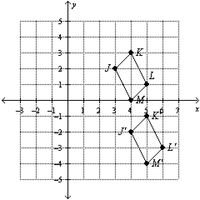rachelmaddie
Full Member
- Joined
- Aug 30, 2019
- Messages
- 851
Graph the image of each figure under a translation by the given vector.
parallelogram JKLM with vertices J(2,3), K(3, 4), L(1,5), M(0,4); < -4, 1 >
I need hints or an explanation on how to solve this.
parallelogram JKLM with vertices J(2,3), K(3, 4), L(1,5), M(0,4); < -4, 1 >
I need hints or an explanation on how to solve this.




